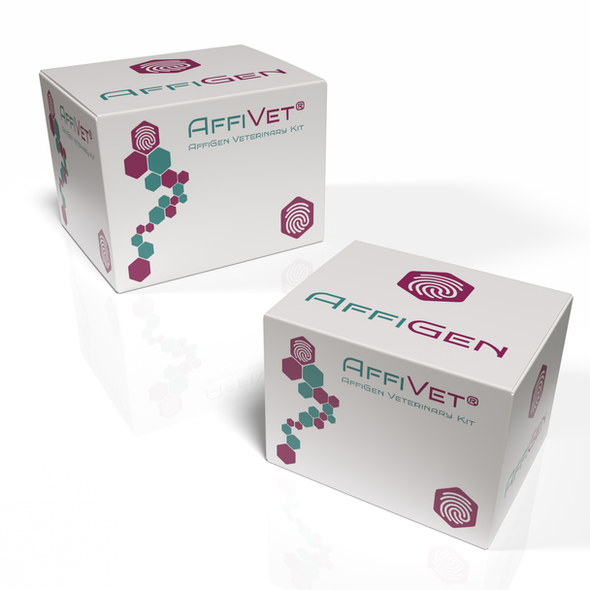AffiVET® PRRSV Antibody Elisa Test Kit
- SKU:
- AFG-VGS-61
- Method:
- Elisa
- Size:
- 192 Wells/kit
- Species:
- Swine
- Specimen:
- Serum
Description
Porcine Reproductive and Respiratory Syndrome Virus (PRRSV) Antibody ELISA kit
1. Brief
The Green® Porcine reproductive and respiratory syndrome virusantibody test kit (PRRSV Ab) is used for the detection of PRRSV antibodies in swine serum; assessment of immunity conditions against porcine reproductive and respiratory syndrome virus in the pig farms;andinvestigation epidemiology of the PRRSV.
2.Principle
The Green® PRRSV antibody ELISA test kit uses the principle of solid-phase enzyme-linked immunosorbent assay (ELISA), and consists of a microwell reaction plate coated with high-purityPRRSV antigen, anti-pig IgG labeled with horseradish peroxidase, and other reagents. The reaction mechanism is that the coated antigen is combined with the PRRSV-Ab in the sample, and then combined with the enzyme-labeled anti-pig IgG antibody to form a "coated antigen+PRRSV-Ab+enzyme-labeled anti-pig IgG antibody" complex.Add adding Substrate,Catalytic reaction color development. The color depth is directly proportional to the amount of PRRSV-Ab. When the color reaction of the sample is detected, the result obtained by the microplate reader exceeds the set threshold, and the result is positive, which indicates that the immune has produced antibodies or there is a natural infection.
3. Components
| 1 | PRRSV antigencoated microplate | 96T X 2 | |
| 2 | Enzyme conjugate | 22ml | yellow lid |
| 3 | Sample diluent solution | 50ml | transparent lid |
| 4 | PRRSV-IgG Negativecontrol serum | 1.5ml | green lid |
| 5 | PRRSV-IgG Positivecontrol serum | 1.5ml | red lid |
| 6 | Substrate | 12ml X2 | orange lid |
| 7 | Stop solution | 12ml | blue lid |
| 8 | 10×concentrated washing buffer | 50ml | white lid |
| 9 | Adhesive Foil | 2 pieces |
|
| 10 | Instruction | 1 piece |
|
4.Material Required not Provided
1 Microplate Reader (Dual-wave length: 450/630 nm).
2 Microplate Washer.
3 Micropipettes, adjustable (Single-wave length 1-100ul、0.5-10ul、multi-wave length 30-300ul).
4 Constant temperature box orwater bath box.
5 Oscillator.
6 Disposable tips (10ul, 200ul)
7 Deionized water
5. Sample requirement
1 The samples are porcine serum, which should be collected with nobacteria. The storage time should be less than 1 week at 2-8℃, if for long term, it should be kept at -20℃.
2 Avoid to use the samples with severe hemolysis, precipitate, contaminated by bacteria or protein suspension.
6. Preparation
1) BringELISA reagents to the room temperature (20-25℃) for 30 min to get best results.
2) Sample dilute: Dilute sample with thesample diluent solution at 40 times(for example: 5ul serum sample+195ulSample diluent solution), the diluted sample need to mix evenly to get better results.
3) Washing solution preparation: Dilute the10×concentrated washing buffer with deionized water at10 times.(eg.10ml 10×concentrated washing buffer + 90mldeionized water ), if there is crystallization in the 10×concentrated washing buffer, it is normal, dissolve it at 37℃.
7.Procedure
1 Adding sample: Take out the required coated plates according to sample quantity (Can be detached) and record the sample position on a worksheet. Set 2 wells for negative control serum and 2 wells for positive control serum, add undiluted negative and positive control serum to its well accordingly, 100 μL/well.Others are wells for samples, add 100μL/well of the dilutedSample.
2 Cover plate with adhesive foil, incubate at 37℃ for 30 min.
3 Remove adhesive foil.Pour the liquid out of the wells, addWashing solution into each well fully, be static for about 10s,pour out directly.Repeat3 times, at last time pat to dry on absorbent paper.
4 Add 100 μL enzyme conjugate into each well.
5 Cover plate with new adhesive foil.Incubate at 37 ℃ for30 min.
6 Repeat step3(washing).
7 Add 100ul substrate into each well, mix properly,incubate for 10 min at 37 ℃ in the dark.
8 Add 50μL stop solution into each well,mix gently for 10sand determine the result.
9 Measure theOD value with a photometer at 450nm/630nm.
8.ELISA analysis
Measure the OD Value of each well, for the assay to be valid the following specifications must be met. Theaverage OD value ofPRRSV-Positive control must be equal to or greater than 0.60, theaverage OD value ofPRRSV-Negative control must be less than 0.15.
The result is judged by S/P value,
S/P=(Sample OD450/630-NCx(—))/( PCx(—)- NCx(—)),NCx(—) means Negative control’s average OD450/630value,PCx(—) means Positive control’s average OD450/630value
If S/P≥0.2, it is positive; less than 0.2, it is negative.
9. Precautions and warnings for users
1. Read the Manual carefully before use.
2. Do not use reagents expired, do not mix reagents from different lots.
3.Experiment rubbish should bedealt with high pressure steam sterilization at121℃ for 30 minutes, or treated with 5.0g/L sodium hypochlorite disinfectant for 30 minutes, then discard.
4.MicroWell plate removed from the refrigerated environment should be balanced moisture to dry at room temperature, then can be opened. Put backunused MicroWell plateintodry foil bagandsealedat4℃.Unused liquid reagent should cover caps,store at 2-8℃ in dark with other group components.
5. Should useMicropipettor to add sample and reagents, and often proof its accuracy.
6. When adding washing buffer, should be full but no overflow, avoid appearing free enzyme at mouth of well or cross pollution between wells.
7. Stop solution is corrosive, use large amount of water to wash immediately when touch the skin or clothes.
Specification
Packing: 96 wells×2.
Expiry date:12 months.
Storage: Storing at 2~8 ℃in the dark, not freeze.






